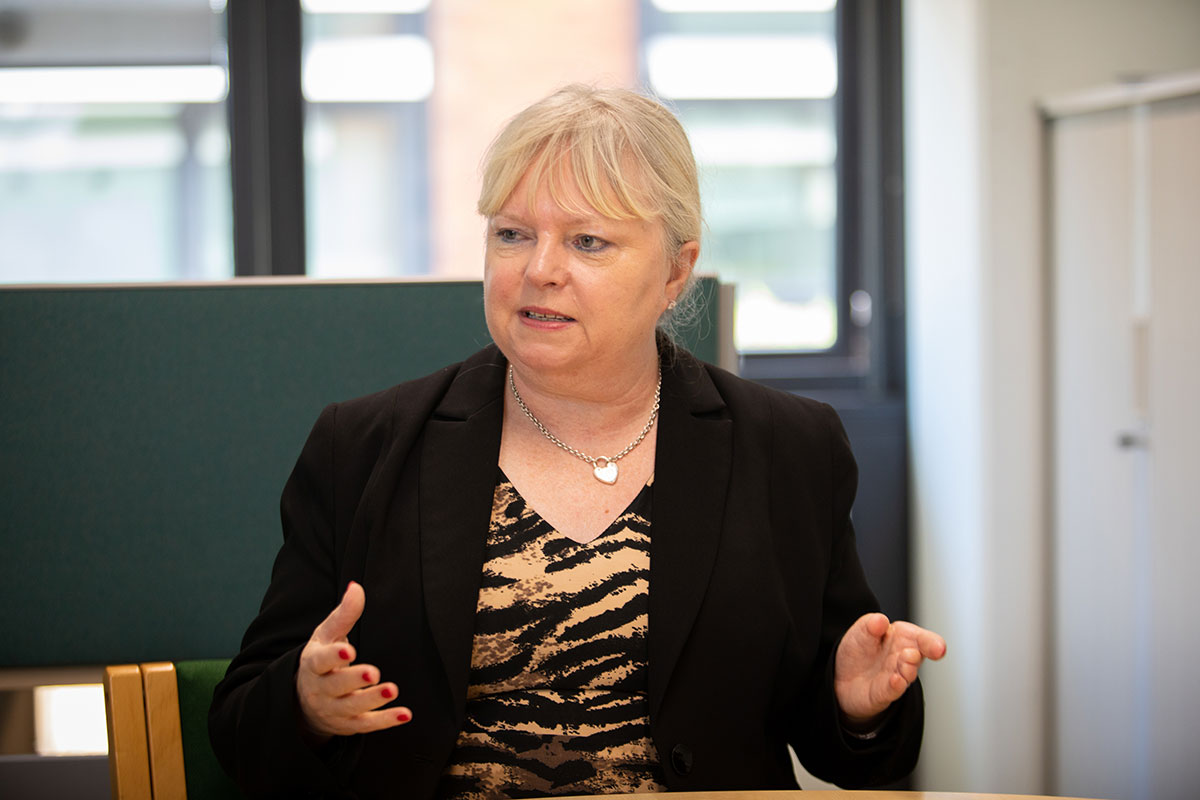‘Why I’m determined to break the silos between housing and social care’ – an interview with the new president of ADASS
In her opening speech as president of the Association of Directors of Adult Social Services, Julie Ogley said she was on a mission to drive closer connections between housing and social services professionals. Martin Hilditch meets her to find out how the housing sector could take advantage. Photography by Jonathan Goldberg
On the face of it, housing and social services departments should have the closest of working relationships. But in reality, despite occasionally making eyes at each other, housing and social care professionals often end up living parallel professional lives. It is a state of play that has long been a source of frustration to the housing sector.
As Paul Smith, director of Foundations, the national body for home improvement agencies, said back in May: “Guidance has called for joint policies between housing and social care since at least 1996 – with little progress across much of the country.”
The Chartered Institute of Housing has also long lobbied for “better integration” of health and social care with the housing sector.
Housing association Bromford probably summed up the status quo best in a blog in which it bemoaned that housing and social care professionals (along with those working in health and education) “go about their business largely in isolation – they congregate at conferences (separately), they lobby politicians (separately), they communicate their ‘message’ (separately)”.
While there are some isolated examples of good practice, by and large this silo approach has been the norm – prompting little more than exasperated hand-wringing at housing conferences.
All that, however, might be about to change. Step forward Julie Ogley, who earlier this year took over one of the most high-profile roles in social care as president of the Association of Directors of Adult Social Services (ADASS).
From the get-go she has positioned herself as a silo buster, stating clearly that she wants to increase joint working between social care and housing professionals – perhaps prompted by her own job, which straddles both disciplines, as director of social care, health and housing at Central Bedfordshire Council.
After all, in her inaugural speech at ADASS’ spring seminar, Ms Ogley told colleagues that she thinks the relationship with housing is as important as connections with the health service.
In the absence of the long-delayed Social Care Green Paper, she said: “I would encourage colleagues nationally and locally to focus on housing and accommodation – lifetime homes, homes for people with care and support needs and their carers or PAs, a safe home for people who have been in an abusive relationship, or just a roof over their head for some people.”
She stated that people working in social care should play an active role in making sure that “councils in their local plans are focusing on the right type of housing for their current and future populations”.
“It takes time and evidence to influence local plans, but if we could have a better offer for older people so that they moved from their large houses – think about the impact this would have,” she added.
On the back of this early mission statement, Inside Housing meets Ms Ogley at ADASS’ Westminster office to find out why she is so driven to join the dots – and what is likely to happen as a result.
Ms Ogley’s background is in social work but right at the start of her career she realised the importance of housing. Originally from Barnsley, she did a social work degree at the University of Hull and then got a job as a social worker with the council. A two-tier authority, social services sat in the county council and housing with the city council.
Ms Ogley worked in an office “in the middle of a set of terrible maisonettes that were in awful condition”.
“They would move all the ladies who had separated from their husbands with young children [into the homes],” she says. “And lo and behold, about half a mile away, across a busy road, was some fairly run-down Victorian housing and that was where probation would house people who had come out of prison for assaulting children. It is looking back that it seems so obvious a problem. But we didn’t think in that systemic way in those days.”
In her early career she worked in county councils – but it was when she moved to Wirral Council in 2000 as an assistant director for older people’s services that she says she got the chance “to know housing colleagues and began to think of ways we could work across that divide”.
For the past 10 years, Ms Ogley has worked at Central Bedfordshire Council with responsibility for both housing and social care. “I deliberately went there because of that housing interface,” she says.
At Central Bedfordshire, her thinking process moved beyond simply connecting frontline housing professionals and social workers. “In my role I have been in the public subsidy or support area of housing, but actually what I have learned from my planning colleagues is that you need to understand how the whole housing market works.”
A study by Central Bedfordshire Council into the delivery of housing for older people provides an example of why social care professionals might benefit from working more closely with housing and planning colleagues. The report predicts that the number of people over 65 will rise from 17.2% of the population in 2015 to 23.3% in 2035 (with those over 85 in Central Bedfordshire jumping from 5,400 in 2015 to 13,700 by 2035).
“In my role I have been in the public subsidy or support area of housing, but actually what I have learned from my planning colleagues is that you need to understand how the whole housing market works”
It adds that suitable housing can “mitigate the effects of some of the health problems associated with ageing – this can also reduce cost pressures on public services like health and social care”.
As a result of its predictions, Central Bedfordshire intervened directly in the market, building a number of extra care housing schemes.
“The council understands that, actually, if you get people living in the right sort of accommodation they are happier and healthier but it is also less [pressure] on the adult social care budget and frees up family housing,” Ms Ogley explains.
And it is not just specialist housing that is important to deliver improvements in social care, she adds. “Quite often people think I am just going to talk about specialist housing, so extra care schemes or housing for adults with a learning disability. Actually, I’m as interested in [delivering] housing that people can afford – so [housing for] careworkers, other sorts of public sector workers that are not paid an awful lot.”
This, she says, has an impact on the ability to deliver social care – or at least for staff and carers to live locally.
“I know in Central Bedfordshire in one town there was only something like three private rented sector properties that became available within the Local Housing Allowance. So where do we expect care workers to live? We have to think about affordable housing.”
Funding for social care is so tight that getting the housing offer right is more important than ever, Ms Ogley feels. “As a council we struggle to recruit care staff,” she admits. Rates of pay mean that care staff are often tempted to leave the profession – she cites the opening of a Center Parcs in Central Bedfordshire a few years ago that tempted some care home staff to change jobs as an example of what can happen. According to Ms Ogley, it shows there is an important national discussion needed about funding social care.
“We still have quite a large part of the sector paid at that national living wage amount. So, is it an attractive career?” she asks.
It is good to hear that Ms Ogley wants to encourage a closer relationship between social care and housing departments. But what advice does she have for colleagues who don’t share her advantage of working in a department with responsibility for both sectors? How do they begin to pull things together?
“Persistence,” she says with a smile. ADASS is looking to help, though. It is set to publish an advice note for directors of adult social services, setting out “why they should be interested in housing”. That is due by the year end, so there is a watch-this-space message from Ms Ogley today.
As for housing colleagues: “If you are not in a joined-up council or directorate, they should also be making overtures,” she states. “We have both got responsibilities for the same population – the same people.”
More broadly, councils should consider being more interventionist to deal with the gaps in housing delivery that are likely to impact on social care, she suggests.
“I know that there are probably about 1,200 households in Central Bedfordshire that are paying at least £27/£37 a week more than their Local Housing Allowance [to cover rent]. So there is a group that technically could fall into homelessness.” There is a dearth of affordable housing being delivered by other developers to cater for this group, she suggests, which is why the council is looking to build new homes through its Housing Revenue Account.
“In one way it is quite miserable being a director at the moment, but in another way I also feel that there is now an acceptance that we have got to change. We have got to find a funding solution”
“So my plea to other councils would be to be prepared to be interventionist,” she adds.
Despite the ongoing financial challenges facing social care professionals, Ms Ogley is optimistic about the future. She says: “In one way it is quite miserable being a director at the moment, but in another way I also feel that there is now an acceptance that we have got to change. We have got to find a funding solution. And I think that is a dialogue with people who live and work in England about how we are going to actually fund social care and what we think social care is for.”
Housing professionals should certainly think about how they take advantage of someone at the top of the tree in ADASS pushing for stronger links with the sector. Inside Housing will publish full details of the advice note when it comes out, too.
Ms Ogley will continue to shout about the virtues of both sectors – largely because their historic lack of national profile has harmed individuals in need of affordable housing and support, she thinks.
“What continues to drive me to work is that my colleagues work with some of the most vulnerable people in our communities – and that is both [those in] social care and housing. They come to work to do a good job. What worries me is that headlines around social care and housing are negative ones and when things go wrong they don’t really recognise the fabulous support that [also] goes on, even though we have got such tight financial constraints.”
With the ongoing absence of a Social Care Green Paper, the future direction of travel is uncertain. Ms Ogley thinks individual councils and housing providers need to set the agenda.
“I think we have got over the moaning about the lack of a green paper and therefore have turned back to being more practical and pragmatic,” she concludes. That means knowing “what we are going to say about the workforce, about digitisation, about housing”.
Ms Ogley is making a start – the housing sector should make sure it takes advantage of the opportunity her presidency seems to offer to forge closer links into the future.
Ageing in Place 2019
Ageing in Place is a new conference brought to you by Inside Housing. It is designed to facilitate dialogue between housing associations, social and health care providers, local authorities, research bodies and technology providers, to create the right housing environment to support older tenants in their own homes.
This one-day event brings together leading industry expert speakers to deliver presentations, panel debates and fireside chats covering the most crucial topics.
Key topics include:
- The demographic time bomb: there are more than 11 million people aged 65 or over in the UK and this figure is expected to rise by nearly 50% in the next 15 years – increasing the need for homes that are designed or adapted for older people
- Collaboration and partnership: we will look at how policies and practices need to be integrated with collaboration across a wide range of agencies including local councils, adult social care, the NHS and local charities
- Design and adaptation for independent living: how to improve independence and quality of life, aid and increase mobility, avoid costs of residential care, prevent falls and other health interventions, and reduce repeat spend on numerous adaptations
- Assistive technology: sharing best practice, through practical examples and key learnings from pilots, schemes and programmes aimed at choosing the right assistive technologies for improving the safety, health and well-being of older, vulnerable tenants so they can stay at home
The conference takes place on 7 October at etc.venues, 8 Fenchurch Place, London.















